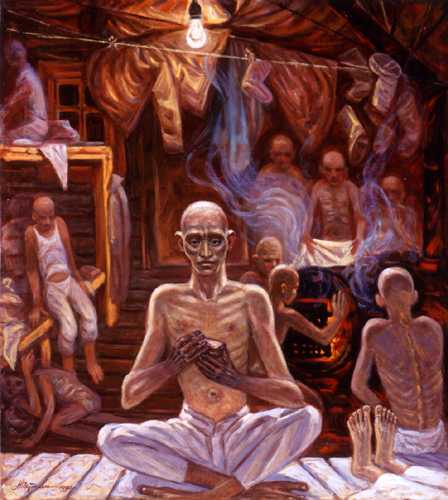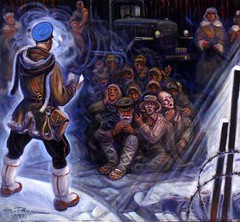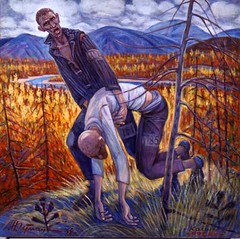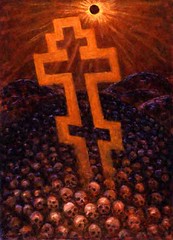
The creative worlds’ failure to spark the public’s moral imagination with projects depicting the horror of the gulag allows the world to ignore the continued presence of those hellish prisons, Daniel Crandall writes.
The list of films using the Holocaust as a plot device is lengthy indeed. The list of films that use the gulag as a plot device can be counted on one hand, and perhaps still have a few fingers available to hold a cigarette (if you’re into that counter-cultural habit) or a cup of coffee. Why do so few filmmakers show an interest in the gulag 20 years after the fall of the Berlin Wall?
It is not hard to think of many excellent films in which the Holocaust figures prominently: Diary of Anne Frank, Judgment at Nuremburg, Schindler’s List, Life is Beautiful, The Reader, The Boy in the Striped Pajamas, and so on. In this short list, the Holocaust is not something of mere passing interest. It is each film’s central plot device. Furthermore, this is a device to which Hollywood returns time and time again.
Films that use the gulag as a plot device are few and far between. In 1968, there was The Shoes of the Fisherman, in which a Catholic priest imprisoned in a Siberian gulag is released. Central to that film, however, is a potential war between Russia and China, not the “labor camp” the priest leaves behind. Just referring to the prison as a “labor camp” diminishes its impact and pushes it into the character’s back-story.
The one film that comes to mind, in which the gulag does play a significant role, is 2003’s I am David. A young boy escapes from a Bulgarian communist prison camp and travels across Europe in order to find the family he was viciously torn from as a child. Most of the film’s action is set in 1950s Europe, but there are several revealing scenes of life in the gulag under the boot of communist oppression.
So why so many excellent films set in or around the Holocaust and so few films using any gulag, be it Soviet, Chinese, Norty Korean, Cuban, etc.?
One explanation for lack of dramatic films set within or using a gulag as a central plot device could be that there is almost no visual evidence of the gulag. While photographs depicting prisoners struggling with life within the frozen hell of a Soviet or Ukrainian prison can be found relatively easily, films are nonexistent. Furthermore, those photos that are available have never been pushed to the forefront of the public’s consciousness.
While there is plenty of archival film footage mostly gained from the liberation of Nazi concentration camps, there is not a single film, of which I’m aware, depicting prisoners in a Soviet gulag during Stalin’s horrific reign. One can find, on the other hand, video of Soviet gulag tourism.
There are other factors that play a role in forgetting about the gulag. Two that come to mind are Left-wing domination of the arts and Leftists’ attempts to diminish the horror of life under communism. Whether it is lack of visual cues or an incapacity for honest self-reflection on the part of the Left, the end result is a lack of imagination among an overwhelming majority of the creative class when it comes to the prison system that lies behind the vast majority of slaughter that occurred during the 20th century.
Even when communists within the gulag system are portrayed, they are depicted in a relatively sympathetic light in contrast to Nazis running concentration camps. In I am David, for example, it is the communist apparatchik running the prison camp who assists David in his escape. Rarely, and rightly, I believe, does one see the same kind of thing in a film depicting the Holocaust.
One painter has attempted to spark the public’s moral imagination with images depicting life in a Soviet gulag. That painter was Nicolai Getman, whose work is currently displayed at the Heritage Foundation. When I struggled with a screenplay about the gulag, I often turned to Getman’s paintings for visual inspiration.
Lee Edwards, of Heritage, has noted, “Getman’s paintings have been called the visual counterpart to dissident writer Alexander Solzhenitsyn’s classic memoir, The Gulag Archipelago.”
Alex van Oss has stated that many museums ignore Getman’s paintings. When he attempted to find a permanent home to protect Getman’s work, among the museums Oss approached “there was reluctance.… [M]useums have a problem with this kind of work because it is not abstract. It’s not difficult. The artist is not putting in some mystery for you or resolve some sort of existential problem. They’re programmatic. What you see is what you get. [Getman] wanted to get out of the way of the picture so that you would have a window into experience.”
The reaction among the art world’s elite is shameful, given the reason Getman gave for producing this work. “I undertook the task,” Getman explained, “because I was convinced that it was my duty to leave behind a testimony to the fate of the millions of prisoners who died and who should not be forgotten.” The neglect by the art world and the larger creative community ensures that these horrors will continue to be forgotten.
Films depicting the Holocaust remind us repeatedly, “Never again.” The failure to portray the gulags in any kind of dramatic presentation allows the world to turn a blind eye to current-day gulags in China, Cuba, North Korea, and elsewhere. In 2003, a documentarian put together a short film depicting Russian labor “camps” where North Koreans are literally enslaved through collusion between the Russian and North Korean governments. Attention in the United States was decidedly muted.
The Berlin Wall came down on November 9, 1989, yet the gulag lives on. Can anyone imagine Nazi-style concentration camps being tolerated today? Much to our disgrace, it is easy to ignore past and present gulags when no one seems willing to depict, in popular dramatic films and television programs, the horror these institutions embody.
–Daniel Crandall

Thank you for pointing out the small efforts made by the entertainment industry to cast a critical eye on communism and communists. One of the best films I can think of that portrays the totalitarian nature of communism is The Lives of Others. Another that brings a humor to what is otherwise a very dark subject is Goodbye, Lenin.
You correctly note that this is a “minor phenomenon.” While a few filmmakers are actually dealing with communism critically, they still fail to deal adequately with the gulag; a failure that contributes to the continued presence of these horrific prisons, euphemistically referred as “labor camps.”
Excellent article, Daniel! The paintings with which you illustrate the piece are quite powerful.
I agree that it’s a scandal that the gulags have been ignored. As to the attitude toward communism in Hollywood and the European cinema, I have seen some positive changes, as noted in articles here, here, here, here, and here.
So far these are just a minor phenomenon. It’s important to keep people conscious of the film community’s denial, through neglect, of the horrors of the gulags, as your article does so effectively.